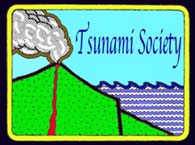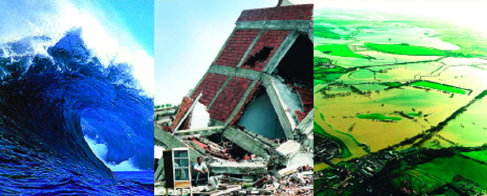|

SCIENCE OF
TSUNAMI HAZARDS
The International Journal of the Tsunami Society

|
Tsunami
Society International
International Journal
SCIENCE OF TSUNAMI HAZARDS
ISSUES - Year 2013
ISSN 8755-6839
..........................................................
ABSTRACTS
for Volume 32, No. 4
ABSTRACTS for Vol 32, No. 4, 2013
Complete Journal - October 2013 - STHVol32N4Y2013.pdf( 20.5 MB ) Compressed Version (1.6 MB) 
METHOD FOR THE ESTIMATION OF TSUNAMI RISK ALONG RUSSIA’s FAR EAST
G. V. Shevchenko, D. E. Zolotukhin, I. N. Tikhonov
Institute of Marine Geology and Geophysics FEB RAS, Yuzhno-Sakhalinsk, RUSSIA
ABSTRACT
A simplified method was developed for estimating the tsunami risk for a coast for possible
events having recurrence periods of 50 and 100 years. The method is based on readily available
seismic data and the calculation of magnitudes of events with specified return periods. A classical
Gumbel statistical method was used to estimate magnitudes of small probability events. The tsunami
numerical modeling study used the average earthquake coordinates in the Kuril-Kamchatka high seismic area. The verification and testing of the method were carried out using events from the North,
Middle and South Kuril Islands – the most tsunami-risk areas of Russia’s Far East. Also, the study
used the regional Kuril-Kamchatka catalogue of earthquakes from 1900 to 2008 - which included
earthquakes with magnitudes of at least M=6. The results of the study indicate that the proposed
methodology provides reasonable estimates of tsunami risk.
Keywords: tsunami risk, earthquake, magnitude, numerical modeling
LATE HOLOCENE TSUNAMI DEPOSITS AT SALT CREEK, WASHINGTON, USA
Ian Hutchinson - Geography, Simon Fraser University, Burnaby, BC, CANADA
Curt D. Peterson - Geology, Portland State University, Portland, OR, USA
Sarah L. Sterling - Anthropology, Portland State University, Portland, OR, USA
ABSTRACT
We interpret two thin sand layers in the estuarine marsh at Salt Creek, on the southern shore of the
Strait of Juan de Fuca, as the products of tsunamis propagated by earthquakes at the Cascadia
subduction zone. The sand layers extend for about 60 m along the left bank of the creek about 800 m
from the mouth, and can be traced to the base of a nearby upland area. One layer is exposed in the
creek bank about 400 m further upstream, but they are only patchily distributed in the rest of the
central area of the marsh. Both layers contain brackish-marine epipsammic diatoms. The lower sand
layer marks a sharp contact between intertidal peaty mud and overlying mud, perhaps reflecting
modest coseismic subsidence in association with tsunami deposition, but little or no change in the
bracketing sediment occurs in association with the upper sand layer. The ages of the sand layers are
not closely constrained, but were most likely deposited by tsunamis generated by great earthquakes at
the Cascadia subduction zone about 1650 and 1300 years ago. The Cascadia great earthquake of
AD1700 may have induced slight subsidence in the marsh, but no tsunami deposit was detected at the
inferred contact. The absence of deposits from the marsh immediately inland of the 4 m-high barrier
beach indicates that the largest tsunamis in the late Holocene at this site have not overtopped the
barrier, which suggests that these tsunamis were likely only 2-3 m high.
Key words: tsunami deposits, diatoms, Cascadia subduction zone, Strait of Juan de Fuca, Washington
A CRITICAL REVIEW AND EVALUATION OF APPLYING SEMI-VOLATILE ORGANIC COMPOUNDS (SVOCS) AS A GEOCHEMICAL TRACER TO INDICATE TSUNAMI BACKWASH: The Bilateral, Deutsche Forschungsgemeinschaft (DFG) and National ResearchCouncil of Thailand (NRCT) Funded Project “Tsunami Deposits in Near-Shore- and Coastal Waters of Thailand (TUNWAT)”
Siwatt Pongpiachan - NIDA Center for Research & Development of Disaster Prevention &
Management, School of Social and Environmental Development, National
Institute of Development Administration (NIDA), 118 Moo-3, Sereethai Road,
Klong-Chan, Bangkapi, Bangkok 10240 THAILAND
Klaus Schwarzer - Institute of Geosciences Sedimentology, Coastal and Continental Shelf Research,Christian Albrechts University Kiel, Otto Hahn Platz 1, D - 24118 Kiel, GERMANY
ABSTRACT
Tsunamis symbolize one of the most harmful natural disasters for low-lying coastal zones and their
residents, due to both its destructive power and irregularity. The 2004 Boxing Day tsunami, which
attack the Andaman Sea coast of Thailand, resulted 5,395 of deaths and inestimable casualties,
interrupted economies and social well-being in numerous coastal villages and caused in extreme
alterations of both onshore and offshore coastal morphology. The Great Indian Ocean tsunami also
highlighted that there are many missing jigsaw puzzle pieces in scientific knowledge, starting from
the generating of tsunamis offshore to the countless influences to the marine ecosystems on the
continental shelf, coastal areas and on land and to the economic and social systems consequences. As
with all deposits that do not have a direct physical link to their causative sources, marine tsunami
deposits must be distinguished from other deposits through regional correlation, dating and criteria for
recognition within the deposits themselves. This study aims to provide comprehensive reviews on
using Polycyclic Aromatic Hydrocarbons (PAHs) as a chemical proxy to discriminate tsunami related
deposits from typical marine sediments. The advantages and disadvantages of this chemical tracer will
be critically reviewed and further discussed.
Keywords: Tsunami Deposits, Marine Sediments, Polycyclic Aromatic Hydrocarbons (PAHs),
Andaman Sea
MARINE CONGLOMERATE AND REEF MEGACLASTS AT MAURITUS ISLAND: Evidence of a tsunami generated by a flank collapse of the PITON DE LA Fournaise volcano, Reunion Island?
R. Paris - Clermont Université, Université Blaise Pascal, BP 10448, F-63000 Clermont-Ferrand, FRANCE
& CNRS, UMR 6524, Magmas et Volcans, F-63038 Clermont-Ferrand, FRANCE
K. Kelfoun - Clermont Université, Université Blaise Pascal, Clermont-Ferrand, FRANCE
& CNRS, UMR 6524, Magmas et Volcans, F-63038 Clermont-Ferrand, FRANCE
T. Giachetti - Department of Earth Science, Rice University, Houston, TX , USA
ABSTRACT
Tsunamis related to volcano flank collapse are typically a high-magnitude, low frequency hazard for
which evaluation and mitigation are difficult to address. In this short communication, we present field
evidences of a large tsunami along the southern coast of Mauritius Island ca. 4400 years ago. Tsunami
deposits described include both marine conglomerates and coral boulders up to 90 m³ (> 100 tons).
The most probable origin of the tsunami is a flank collapse of Piton de la Fournaise volcano, Réunion
Island.
Keywords: tsunami deposits; volcano flank failure; Mauritius Island; Reunion Island
Copyright © 2013 - TSUNAMI SOCIETY INTERNATIONAL
______________________________________________________________________________________________________
All Issues of Science of Tsunami Hazards prior to 2006 are also available in pdf format at mirror site
http://epubs.lanl.gov/tsunami/
------------------------------------------------------------------------
SCIENCE OF
TSUNAMI HAZARDS
Journal of Tsunami Society International
ISSN 8755-6839
Abstracts, full papers and individual volumes
All Past Issues
from 1982 - archived by volume, title and names of authors
_____________________________________
SCIENCE OF TSUNAMI HAZARDS
Journal of Tsunami Society International
Copyright © 1978 - 2013 - TSUNAMI SOCIETY INTERNATIONAL
TSUNAMI SOCIETY INTERNATIONAL, 1741 Ala Moana Blvd. #70, Honolulu, HI 96815, USA.
WWW.TSUNAMISOCIETY.ORG
------------------------------------------------------------------------
All Issues of Science of Tsunami Hazards prior to 2006 are also available in pdf format at mirror site at U.S. Los Alamos National Laboratory
http://epubs.lanl.gov/tsunami/
------------------------------------------------------------------------
| |
|
© 2013 Tsunami Society International- All rights reserved
Last update: OCT., 2013 |
|
|
| |
|
|
|
|
|
|




